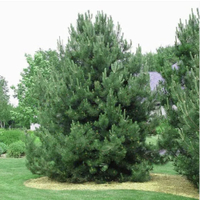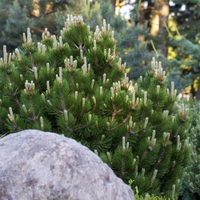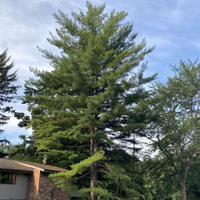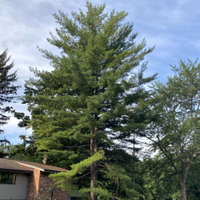Best pine trees – 11 sculptural choices for yards of all sizes
Bring evergreen textures to the garden, with options for tall specimens and ground-hugging, shrubby types
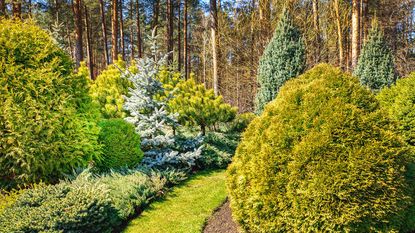

The best pine trees have long been valued as a good source of timber: for their evergreen qualities and often aromatic leaves or needles; and for their ability to grow at altitude, in poor soils, and in some cases for withstanding pollution.
You will see them growing in diverse locations as many species travel very well. The choice of cultivars, from towering, full-sized specimens to dwarf varieties, offers options to gardens of all sizes, and they bring structure, texture and year-round interest. (The Scots Pine, Pinus sylvestris, is however classed as invasive in the United States.)
Evergreen trees are often very resinous, however, which makes them a fire risk, so bear this in mind when considering planting locations.
11 of the best pine trees for your backyard
When selecting a tree be aware of the growing conditions, hardiness zone and soil type to ensure you are getting the right plant for your space.
It can take work to get trees established - they are an investment. So be sure to choose a pine tree which works for your backyard.
1. Pinus sylvestris ‘Watereri’
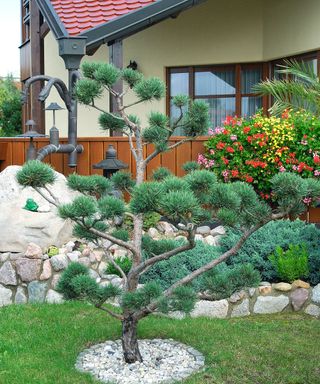
- Hardiness: USDA 2-9
- Height: 6ft
- Spread: 6ft
With glaucous green needles, ‘Watereri’ offers a smaller alternative to the far loftier Scots Pine. It’s a slow grower, making it one of the best pine trees for small gardens – growing approximately 6-8in a year.
And with its compact, upright habit, it makes a good choice if you’re looking for a structural evergreen focal point. If trained as a multi-stem specimen, this adds to its value, revealing the typical reddish attractive winter bark as wonderful textural contrast.
Pinus sylvestris are not generally recommended for planting in the US, as they are now categorized as an invasive plant, but this tight little cultivar makes a good manageable alternative. ‘Watereri’ is also sometimes found under the names ‘Nana’ and ‘Pumila’.
2. Austrian pine 'pinus nigra'
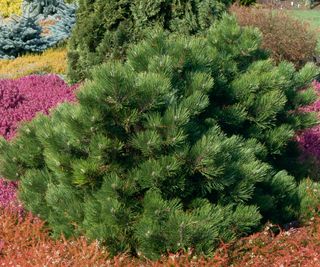
- Hardiness: USDA 1-5
- Height: 150ft
- Spread: 40ft
This is a large pine, native to the forests of central-southern Europe, with a darker bark, reflected in its name. Traditionally used for timber production, its statuesque presence gives it an ornamental dimension.
It looks better planted in a more natural forest setting, with multiple pine specimens, and it has naturalized in parts of the northern USA and Canada. If you live in a coastal area look for the variety 'Austriaca’.
If you live in growing zones 3 - 8 then this sprinter pot of pine will be useful as a windbreak or noise absorber, adding privacy and shelter to your yard. They work as a single specimen or planted in groups.
3. Pinus mugo
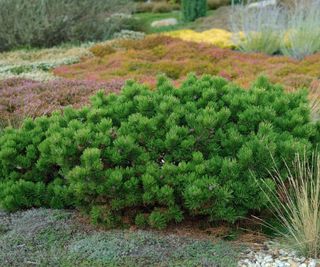
- Hardiness: USDA 3-7
- Height: 9ft
- Spread: 16ft
The dwarf pine is not a fast-growing tree, and so is a favorite for its compact, rounded form and amazing ability to tolerate tough conditions.
A great choice for a wide range of yard sizes, whether growing in the ground or a large container, it makes a neat evergreen punctuation point in a landscape – it’s a popular choice alongside modern landscaping ideas.
There are many cultivars to choose from, varying in diminutive size or coloring. For example, ‘Carstens’ has a golden winter hue.
Six pack of Dwarf Mugo Pine at Fast Growing Trees
Buying in bulk means that you can space these dense hummocks of dwarf pine throughout your garden. Or use them to line a path or flower bed.
4. Pinus parviflora ‘Negishi’
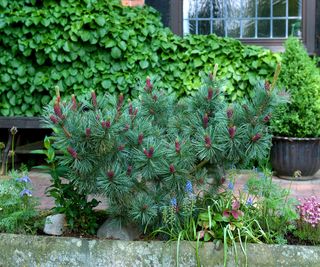
- Hardiness: USDA 5-10
- Height: 3ft
- Spread: 2ft
The Japanese white pine is another slow-growing tree, with long, silvery-green needles, offering options for smaller-scale pine planting and bonsai specimens. ‘Neigishi’ is a very petite cultivar with a neat upright habit and attractive shape.
It's one of the best trees to grow in pots and small garden spaces. Other recommended Pinus parviflora cultivars range from the tiny ‘Hagoromo Seedling’ that reaches a mere 10in, to the small tree-sized ‘Glauca’.
If you want to go really small, ‘Miyajia’ will grow up to 3ft when mature but has been traditionally used for bonsai trees.
5. Pinus pinea
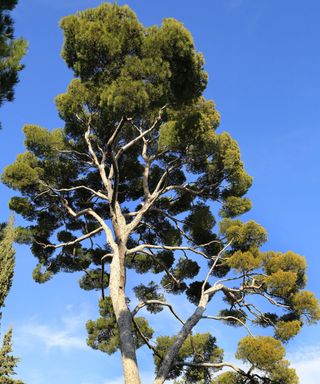
- Hardiness: USDA 9-11
- Height: 70ft
- Spread: 50ft
This is the classic Italian stone pine, with its umbrella-shaped canopy topping a tall trunk clothed with warm, russet-colored bark. It’s a stunning sight when it grows to its mature size.
Grown traditionally for the tiny, but nutritious and delicious pine nuts, it also makes one of the best trees for shade, with a great capacity to tolerate heat, drought and salty air.
It’s a good drought tolerant tree choice for coastal gardens, but you do need space to allow it to reach its potential, so not one of the best pine trees for the city, or an average-sized yard.
6. Pinus strobus
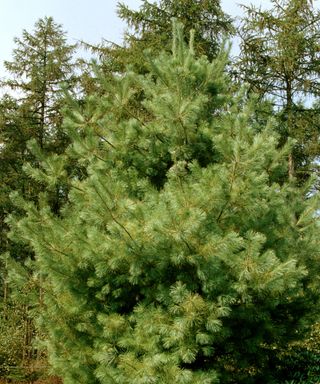
- Hardiness: USDA 3-9
- Height: 80ft
- Spread: 40ft
This North American native is also known as the Eastern White Pine, the Northern White Pine and the Tree of Peace. It’s commonly found in areas east of the Rocky Mountains and was once very widespread, dominating the landscape.
With a fast growth rate of around 3ft per year, this is the tallest conifer in the eastern states, and it needs space to reach its potential. It also has a very long lifespan and specimens that are 400 years old have been found.
There are many strobus cultivars that offer a choice in size and the form of the needles, like the weeping ‘Pendula’ and twisted ‘Contorta’, and golden variations as seen in ‘Louie’. If you like the long smooth needles, there are smaller, dwarf varieties, including ‘Nana’ and ‘Blue Shag’.
Eastern White Pine (pinus strobus) at Fast Growing Trees
This species of pine is hardy right down to -30. It's a large tree which will last for generations in pretty much any environment.
7. Pinus taeda

- Hardiness: USDA 1-7
- Height: 80ft
- Spread: 40ft
According to the American Conifer Society, this species of pine, perhaps more commonly known as the Loblolly pine, is one of several native to the southeastern United States. Spreading from central Texas, east to Florida, and north to Delaware and southern New Jersey.
It's a good tree for clay soil which is slightly acidic, that are typically found in the southern states. A tall, fast-growing tree, it’s often found colonizing deserted ground and, with its rangy habit, it looks best when planted in naturalistic-style groves.
It’s a good choice in terms of conservation as a tree for wildlife.
Loblolly pine (pinus taeda) at Nature Hills
Currently available at almost half off the original price. This is a great tree for rain gardens in zones 6 - 9. 'A terrific shade tree with lots of character', according to Nature Hills.
8. Pinus ayacahuite
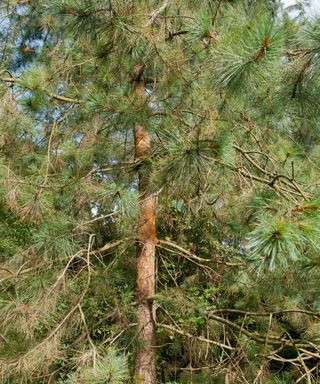
- Hardiness: USDA 6-9
- Height: 150ft
- Spread: 25ft
Also known as the Mexican white pine, this grows in moist climates found typically in forested, mountainous, eastern areas of Mexico and Central America. It was traditionally exploited for its timber, and is now less common in its natural habitat.
It’s a very tall tree – known as ‘cloud tree’ by the Aztecs – which makes it unsuitable for the average garden, and best appreciated in an arboretum or broader landscape.
But, if you're looking for landscaping ideas for a sunny area at altitude, it would add a naturalistic slant to the planting.
9. Pinus jeffreyi
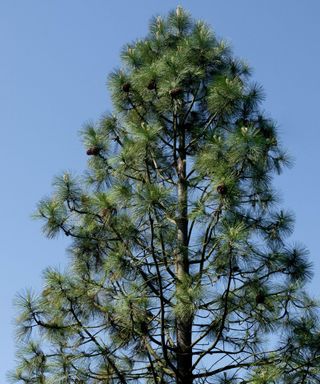
- Hardiness: USDA 5-8
- Height: 120ft
- Spread: 12ft
The Jeffrey pine is a classic North American pine, native to the southwestern US and a familiar sight in the landscape there. It’s always worth considering native species, as they support the local wildlife population, and are better suited to the climate.
As Paul Smith, an expert plant ecologist and conservationist and author of Trees: From Root to Leaf, available at Barnes and Noble says: 'Pines belong in their centers of endemism, in the boreal forest, as well if you broaden it out to all conifers. We always try to promote planting native species because the knock-ons for other biodiversity are enormous.'
For use in your own wildlife garden, try the compact P. jeffreyi cultivar ‘Joppi’ that grows to around 9ft.
10. Pinus banksiana
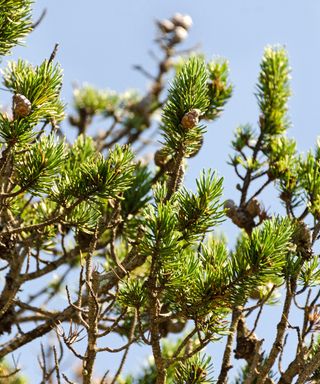
- Hardiness: USDA 3-8
- Height: 30-70ft
- Spread: 26ft
Also known as the Jack pine, this is a medium-sized North American native, found growing from right across the northernmost parts of the continent from east to west coast.
P. banksiana makes an interesting choice for its often irregular and contorted growth habit, and for its toughness and ability to grow in poor soils.
Cultivars include the very droopy and almost prostrate 'Uncle Fogy', which is good for pruning into whatever topiary shape you want.
P. banksiana is sometimes confused with its close relative Pinus contorta that’s more commonly found growing on the west coast of the US.
11. Pinus wallichiana

- Hardiness: USDA 5-8
- Height: 40ft
- Spread: 26ft
The Himalayan white or Bhutan pine, P. wallichiana, is a tall and broad tree, with very attractive, long, silky needles and very large cones. It makes a real statement in bigger landscapes – you might spot it in arboretums and botanic gardens. It’s also prized for its tolerance to pollution.
The ‘Nana’ cultivar that grows to 9ft makes a good choice for a small garden. The more uncommon ‘Zebrina’ is a larger tree at 30ft high by 20ft spread, with striped needles which are really decorative.

Most pine trees will grow quickly in the right planting conditions

Lisa is co-founder of Urban Forest Pro, a tree care company based in Portland, Oregon, U.S. An ISA Certified Arborist.® Lisa has been in the tree care business for over 20 years and has established a great reputation as a tree care expert within the industry.
FAQs
What is the most hardy evergreen tree?
'Most pine trees are hardy to at least zone 6,' says Lisa Tadewaldt, tree care expert at Urban Forest Pro.
'A short list of ones that are hardy to zone 2 is Jack Pine, Red Pine, and Mugo Pine. If you are looking for the hardest-to-kill pine it is going to be an Austrian pine, in my opinion and it is hardy to zone 4.'
What is the fastest-growing type of pine tree?
'Most pine trees have a medium growth rate,' says Lisa Tadewaldt, tree care expert at Urban Forest Pro. 'No particular tree is going to grow much faster than another. There are a few that grow very slowly so it is a good idea to research the growth rate before purchasing.'
'If you are looking for a fast-growing evergreen better to go with a Cypress instead,' suggests Lisa. 'It is important to know that when you seek out fast growth you give up strength in the wood, so these are not good choices for near buildings.'
Many environmental factors can influence the speed of growth. Lisa explains: 'Generally, most species of the best pine trees will grow rapidly in ideal conditions. Pinus nigra or the Austrian pine is one of the species which performs best in USDA zones 6-9.'
There is a surprising amount of diversity when it comes to pine trees. The height variety alone combines dwarf species acting as bushy ground cover, and towering types which will reach 40 plus feet. Then there's the wonderful array of textures and scents, which will lift a garden. If chosen correctly, a pine tree is also guaranteed to benefit the wildlife and natural ecosystem of your backyard.
Sign up to the Homes & Gardens newsletter
Design expertise in your inbox – from inspiring decorating ideas and beautiful celebrity homes to practical gardening advice and shopping round-ups.

In her years of gardening, Camilla has designed planting schemes for gardens large and small in and around London, written about plants and how to grow them, and worked on BBC gardening TV shows in the UK. She's also works as a therapeutic horticulturist, teaching growing for wellbeing and mental health.
-
 5 colors to never pair with gray according to designers – to ensure you make the most of this cool-toned neutral
5 colors to never pair with gray according to designers – to ensure you make the most of this cool-toned neutralWhat colors should you never pair with gray? According to interior designers and color experts, these five colors should be avoided next to this cool-toned neutral
By Emily Moorman Published
-
 How to introduce children to chores – 9 ways to inspire little helping hands
How to introduce children to chores – 9 ways to inspire little helping handsIntroducing children to the concept of chores early on encourages a lifetime of helpful habits, not to mention makes your life easier – here’s how to do do it, according to the pros
By Tara King Published
